Gardens of Sweden – Hallekis Manor and Lacko Castle
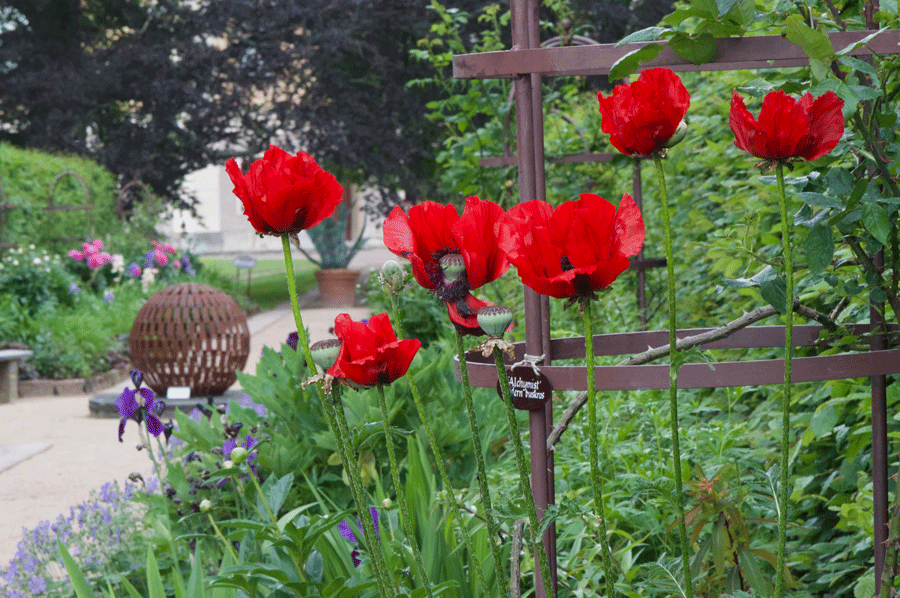 Garden writer, Susie White, presents the second of a three-part mini-series on the Gardens of Sweden.
Garden writer, Susie White, presents the second of a three-part mini-series on the Gardens of Sweden.
After a good breakfast at Naas Fabriker I went north to see two gardens on the shores of Lake Vanern, Sweden’s largest lake. It’s a fascinating area to drive through with undulating farmland dotted with red-painted wooden houses and 12th century churches. Lupins have become an invasive species in Sweden, colouring roadsides in purple and pink spires and sometimes entire fields. As well as field poppies, it was a delight to see the blue of cornflowers amongst the wheat.
The garden of Hallekis Manor was mentioned by Carl Linnaeus on his journey through West Sweden in 1746 and the site was chosen for its shelter and fertile soil. Tucked between Kinnekulle mountain and the lake, it has unusual winter warmth. Head gardener Joachim Löfgren, who showed me around, told me: “The temperature is more like that of southern Sweden and there can be frost all around us but not here.”
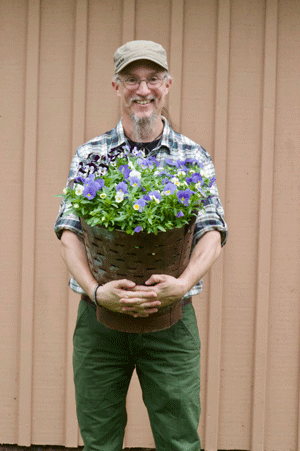 Linneaus mentions that walnut trees could be grown at Hallekis thanks to the microclimate. “Last year,” said Joachim (pictured left), “we harvested 10,000 walnuts from just two trees!” The arboretum which is close by the manor house has 120 unusual trees and includes two species previously known only from fossil specimens: dawn redwood, Metasequoia glypstotroboides, and ginkgo, Ginkgo biloba. The ginkgo, a female was planted in 1902 and is one of the oldest in Europe; a male has now been planted nearby. There are two other trees that are rare for West Sweden, Catalpa bignoides and sweet chestnut. A curiosity is the Laburnocytisus ‘Adamii’, a graft hybrid between laburnum and broom, that bears hanging purple and yellow flowers on the same tree.
Linneaus mentions that walnut trees could be grown at Hallekis thanks to the microclimate. “Last year,” said Joachim (pictured left), “we harvested 10,000 walnuts from just two trees!” The arboretum which is close by the manor house has 120 unusual trees and includes two species previously known only from fossil specimens: dawn redwood, Metasequoia glypstotroboides, and ginkgo, Ginkgo biloba. The ginkgo, a female was planted in 1902 and is one of the oldest in Europe; a male has now been planted nearby. There are two other trees that are rare for West Sweden, Catalpa bignoides and sweet chestnut. A curiosity is the Laburnocytisus ‘Adamii’, a graft hybrid between laburnum and broom, that bears hanging purple and yellow flowers on the same tree.
Four colour themed perennial borders are backed by hedges. Rusty plant supports pick up on the colour of a huge copper beech and the borders are full of sumptuous peonies, irises, oriental poppies, geraniums and scented daylilies. At the centre is a globe sculpture made from parts of recycled farm machinery by Den Flygande Gnistan – The Flying Spark.
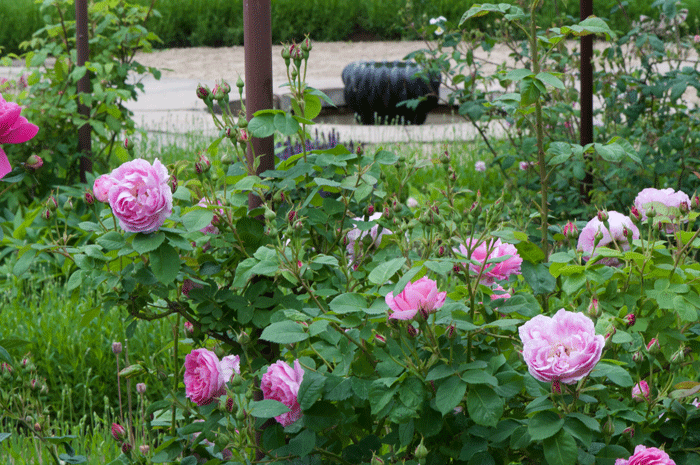 (above: Rose Garden at Hallekis)
(above: Rose Garden at Hallekis)
At the end of the borders is a circular rose garden of highly scented old-fashioned varieties with lavender ‘Munstead’. Joachim explained that he cuts the lavender back hard twice a year to keep it compact, in April and in early August. As with all the gardens I visited, it is run on organic principles. The cafe at Hallekis was in an old vine house and I had a delicious lunch of wild garlic soup with home made bread sitting beneath the apple trees.
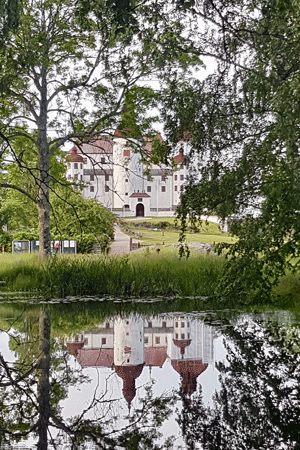 On the other side of a bay is Läckö Castle, (pictured right) a Baroque mansion of whitewashed walls, towers and turrets with dark red roofs. It is here that Simon Irvine has made an exemplary vegetable garden laid out in waves and patterns: “I want to show people how beautiful vegetables are,” he told me. “There are no labels so visitors have to ask the gardeners about the plants and I think it’s part of my job to talk to people. A garden is a meeting place.”
On the other side of a bay is Läckö Castle, (pictured right) a Baroque mansion of whitewashed walls, towers and turrets with dark red roofs. It is here that Simon Irvine has made an exemplary vegetable garden laid out in waves and patterns: “I want to show people how beautiful vegetables are,” he told me. “There are no labels so visitors have to ask the gardeners about the plants and I think it’s part of my job to talk to people. A garden is a meeting place.”
“We have 50 acceptable weeds,” he says. “Plants such as musk thistle, milk thistle and onopordum. I like not being in control.” Goldfinches feed on their seedheads and the garden is full of bumble bees and butterflies. Simon lets cow parsley, red valerian, yellow corydalis and viper’s bugloss seed themselves along the castle terraces, along with fennel, a favourite of his, marigolds and echinops.
In winter the lake can be frozen solid until mid April. The castle stands on a promontory so it is surrounded by ice and freezing winds. It’s simply not possible to work the garden then, though the stony ground does help to keep some warm: “I usually can’t start digging until the end of April,” Simon said.
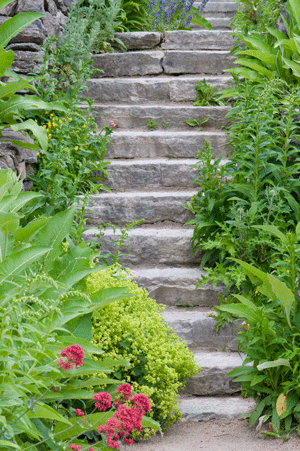 He has added lots of compost to the already fertile soil and likens making compost to making sourdough bread. Some of the previous heap is used as a ‘starter’ and these heaps are large at 20 cubic metres and 1.6 metres high, built in layers and incorporating hay from the meadows. A great advantage of Sweden’s growing conditions is daylight length so plants grow tall. Cardoons grow to 2 metres. (pictured left: side terrace steps with self seeders Läckö Castle.
He has added lots of compost to the already fertile soil and likens making compost to making sourdough bread. Some of the previous heap is used as a ‘starter’ and these heaps are large at 20 cubic metres and 1.6 metres high, built in layers and incorporating hay from the meadows. A great advantage of Sweden’s growing conditions is daylight length so plants grow tall. Cardoons grow to 2 metres. (pictured left: side terrace steps with self seeders Läckö Castle.
The walled garden enables vegetables to be grown until the end of October. The curving sensual lines include colourful varieties – beet ‘Bull’s Blood’, beet ‘Crapaudine’, lettuce ‘Batavia’, lettuce ‘Veneziana’, new chards from Switzerland and the Plainpalais Silver Thorny Cardoon. Simon harvests 60-70 heads of lettuce a day which are used by the nearby restaurant ‘Hvita Hjorten’ (The White Hart) in the Naturum visitor centre on the edge of Lake Vanern. Clad in narrow bands of wood that echo the reed beds, Naturum has exhibits about wildlife, geology and plants as well as accommodation and it is where I stayed the night.
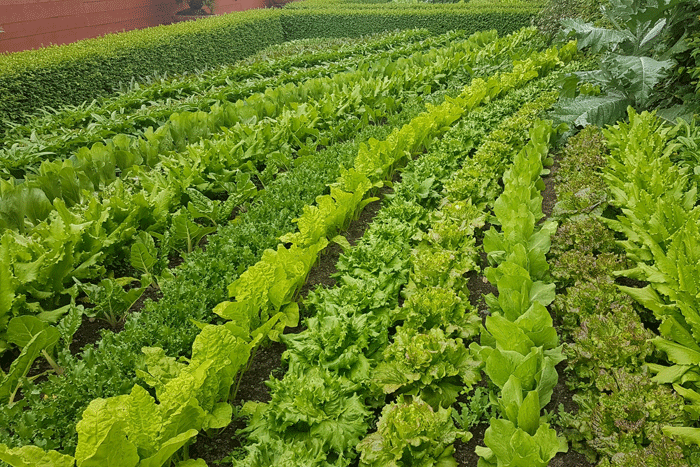 (above: vegetable in patterns at Läckö Castle)
(above: vegetable in patterns at Läckö Castle)
Hvita Hjorten is well known for its superb food made using local ingredients. Chefs Katrin Ljungblom and Stefan Söderholm work closely with Simon in using the produce from the beautiful vegetable garden at the castle. I had a delicious meal of pike-perch from the lake in a butter sauce with oyster plant, yellow pea hummus and grilled curly endive from Simon’s garden. Potatoes were flavoured with fennel and chive flowers, dill and fennel being very popular herbs in Sweden. Pudding was a blackcurrant sorbet with dried birch shoots and thyme, beetroot marinated in blackcurrant, and Creme caramel. Wow!
In Part Three of this mini series, I’ll be visiting two final gardens, Jonsered Manor near Gothenburg and Sammels Farm with its meadows, herbs, apple trees and plants for bees.
Susie White was a guest of Visit Sweden.
All images are strictly ©Susie White

